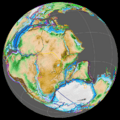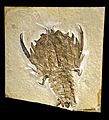Jurassic facts for kids
The Jurassic Period was a long time ago, from about 201.3 million years ago to 145 million years ago. It was the middle part of the Mesozoic Era, which is often called the "Age of Reptiles." The Jurassic came after the Triassic Period and before the Cretaceous Period. It was a time when huge dinosaurs roamed the Earth!
Contents
Jurassic Climate
During the Jurassic Period, the Earth was much warmer and wetter than it is today. There was also more carbon dioxide in the air, and sea levels were higher.
Imagine much of Western Europe covered by a shallow sea, maybe less than 100 meters deep. This was because the supercontinent Pangaea was slowly breaking apart, creating a narrow Atlantic Ocean. The water in these seas often had low levels of oxygen. This meant that dead plants and animals didn't fully rot away. Instead, their remains formed special mudstones that are rich in organic material. These mudstones are now a major source of North Sea oil.
Moving Continents: Plate Tectonics
During the early Jurassic, the giant supercontinent called Pangaea started to split apart. It broke into two main parts: Laurasia in the north and Gondwana in the south. This splitting process, called rifting, took a very long time.
As the continents pulled apart, lava poured out from cracks in the Earth's surface and from volcanos. By the end of the Jurassic, South America had begun to separate from Africa. In North America, mountain ranges started to form as the tectonic plates slowly moved west. The North American plates moved over the Pacific Ocean plates, which helped create the Rocky Mountains.
Amazing Life in the Jurassic
The Jurassic Period was a fantastic time for many kinds of animals, especially reptiles. Dinosaurs, pterosaurs (flying reptiles), and marine reptiles like Ichthyosaurs and Plesiosaurs were everywhere! They filled many different places in the environment.
In the seas, there were big changes too. New predators like starfish, crabs, and snails that could drill holes became common on the sea floor. They ate many of the creatures living there. Clams and oysters (a type of mollusc) also became very common along the shores.
Early mammals were around, but they were mostly small creatures. They often lived in burrows, staying out of the way of the much larger reptiles. Interestingly, the first fossils of small dinosaurs with feathers, like Anchiornis, come from the Jurassic. And the very first fossil bird, Archaeopteryx, also lived during the late Jurassic Period.
Jurassic Plants
The main plants on land during the Jurassic were gymnosperms, especially conifers (like pine trees). You would also see lots of ferns, tall horsetails, "monkey puzzle" trees, ginkgos, and cycads.
These plants were quite tough and not as easy to digest as modern flowering plants. This might be why some plant-eating dinosaurs, like the giant sauropods, grew so incredibly large during the Jurassic. Their huge size would have helped them digest these tougher plants over a longer time.
Related pages
Images for kids
-
Portrait of Alexandre Brongniart, who coined the term "Jurassic"
-
Middle Jurassic strata in Neuquén Province, Argentina
-
The breakup of Gondwanaland took place during the Late Jurassic, the Indian Ocean opened up as a result
-
Holotype specimen of Platysuchus, a telosaurid thalattosuchian
-
Fossil of Ichthyosaurus somersetensis at the Natural History Museum, London
-
Skeleton of Rhamphorhynchus muensteri at Teylers Museum, Haarlem
-
Archaeopteryx lithographica from the Late Jurassic (Tithonian) of Germany
-
Skeleton of Heterodontosaurus, a primitive ornithischian from the Early Jurassic of South Africa
-
Skeleton of Mamenchisaurus sinocanadorum from the Middle-Late Jurassic of China
-
Lichnomesopsyche daohugouensis , an extinct mesopsychid scorpionfly from the Late Jurassic of China
-
Vadasaurus herzogi, a rynchocephalian from the Upper Jurassic Solnhofen Limestone of Germany
-
Skeleton of Ceratosaurus, a ceratosaurid from the Late Jurassic of North America
-
Skeleton of Monolophosaurus, a basal tetanuran from the Middle Jurassic of China
-
Restoration of Yi qi, a scansoriopterygid from the Middle to Late Jurassic of China
See also
 In Spanish: Jurásico para niños
In Spanish: Jurásico para niños
































